"When I woke up this morning could have sworn it was Judgment Day"
Humanoids publishes some cool comics, and I get some of them (they tend to be spendy, so I skip some not because they look bad, but because they just look a bit too dear), like Millennium. I mean, come on - this comic is about a relics merchant who moonlights as a proto-P.I. at the end of the first millennium. It's like it was written just for me!!!!! Millennium is written by Richard D. Nolane, drawn by François Miville-Deschenes, and colored by (wait for it) Sabrina Lim, Fabien Alquier, Daniel Perez, Tatto Caballero, H. Sebastian Facio, and Miville-Deschenes chips in as well. It's translated by Natacha Ruck, Ken Grobe, and Lindsay Marie King.
To be fair, it's five separate chapters, released over several years, so it's not surprising several colorists worked on it. It costs $39.95, but it is 285 pages long, so it's a pretty good value.
The book is really five somewhat inter-related chapters, each telling a story of its own but linking to others in many ways. I imagine that they were released as separate albums, and they can easily be read as separate entities, but they are telling a larger story about the supposed end of the world, which may or may not have already occurred. Nolane sets the book in a slightly parallel world than ours, which I learned from this book is called a "uchronia" (comics expand your vocabulary!). The book takes place over a period of about 6-8 months, from autumn 997 to spring 998, with some flashbacks to earlier times sprinkled in. Raedwald the Saxon and his good buddy Obelix - I mean, Arnulf - wander the European countryside, getting into all sorts of trouble. His job as a relics merchant is crucial, because it means he can wander the European countryside (for centuries, people rarely moved around too much from their birthplace), and it also allows him to hobnob with the important people of the time, the nobility and the clergy, as well as meet many different kinds of people and gain a lot of knowledge.
So when he applies his detective skills to a problem, he's able to draw on a vast fount of wisdom to help him solve mysteries that might otherwise be insoluble. Raedwald's Europe is just a bit different than ours - in our world, Hugh Capet, the king of France, died in 996, but in Millennium, he came back to life and no one seems to have too big an issue with this. This Europe is more magical than the "real" one - when the characters speak of ghouls, they mean actual horrible creatures who stalk the landscape, for instance. The most radical change is the presence of aliens, called "sylphs," who don't show up very often and use human agents - "changelings" - to do their bidding. The sylphs (the word "sylph" was apparently coined in the 1500s by good old Paracelsus, but Nolane uses it anachronistically but cleverly, as it means a spirit of the air) have been around for centuries, and no one is terribly fazed by their existence - they and the changelings they place in positions of power are simply part of the political landscape, and everyone has to account for them. Nolane doesn't make it clear if the reason magic exists - relics of saints actually work in the comic, for instance - is because the sylphs exist, but that's just the kind of world it is.
In this world, Raedwald is an anomaly, which is always the best kind of protagonist - someone who stands out as different from the mass of humanity around him. He sells relics and is a committed Christian, but he doesn't let faith blind him to the facts of a case.
When the monks of Santenay Abbey believe that their patron saint, Polycarp, has abandoned them, they come up with a ritual to get back in his good graces, but don't really try to figure out what happened. Raedwald figures everything out, simply by listening to testimony from various people and refusing to jump to conclusions about the people involved. Nolane makes an interesting point about Polycarp's disapproval - the monastery at Cluny, which propagated the Benedictine Rule and gained immense power during the Middle Ages, in this reality is aggressively trying to dominate every monastery, with their "Hounds of God" - white-robed monks - roaming the countryside and ingratiating themselves with the rich and powerful. If they find out that Polycarp has abandoned Santenay, it would make it easier to take over, and Raedwald knows that's not a good idea. So Nolane not only writes a detective story, it's a story about how power is gained and held and lost during this time period and what groups will do to expand their influence.
Through the book we get a nice tour of Europe, as Raedwald and Arnulf start in France; head north to England (Raedwald is sent by the pope to recover a coffer that belonged to St. Peter, which ended up far to the north of the British Isles), where our hero helps Æthelred II (known as "the Unready," which is a bad translation, although he wasn't a great king) thwart the ambitions of Cluny and hooks up with Rowena, an English sailor with her own boat;
end up in Scandinavia (after recovering the coffer, Rowena's boat is blown off course and destroyed by a Kraken), where Raedwald solves a murder, they befriend some Vikings, and our hero actually sees a sylph spacecraft buried in an icy lake; go back to Paris, where they put the kibosh on a conspiracy to implicate the city's Jews in a murder and find out some disturbing things about the crucifixion of Jesus (and where Rowena leaves them to go back to the sea); and end up in Rome, where Raedwald discovers something else about Jesus's birth which might throw off the timing of the Apocalypse. All of these stories have their own little side plots, as the Hounds of God continually show up to harass our heroes, and they in turn dispense justice to random evil-doers. They also spend a good deal of time drinking (well, Arnulf does) and swiving (well, Raedwald and Rowena do, and Raedwald always seems to interrupt Arnulf just as he's about to). Nolane takes his time with the plots so that we can see all the horrible glory of millennial Europe - it seems like a fairly nasty place, with sudden violence (the book begins with a caravan being attacked and everyone in it killed and/or raped) and terrible hygiene. There's absolutely no privacy, and everything is muddy. In many places (like Rome), the glorious past is still present, but it's decayed so much that the entire city looks like a slum.
Part of this has to do with Miville-Deschenes's art, which is excellent.
Like many European artists, he doesn't get to waste space, as there are no double-page splashes in this comic and every panel is packed with detail. His people are wonderfully drawn - in the back of the book, Claude Ecken notes in the afterword that Miville-Dechesnes makes the women a bit more glamorous than they would have been, but that's true of almost all historical comics - and reflect the society of a thousand years ago very well, as all the many social classes are represented nicely. Miville-Deschesnes doesn't shy from showing the casual bloodshed of the age - at one point a bishop's wagon simply crushes a drunk in the street and moves on - and the decadence of much of Europe at the time. He gets to draw a lot of fighting, and his beautiful, fluid work makes them all very exciting. He remembers that Europe of 1000 was a rural society, so the natural world mixes freely with the urban world, and Miville-Deschesnes is very good at showing how the two worlds clash and fold into each other. While he doesn't shy away from the violence, he doesn't show so much that the book becomes too gory, which makes it more adventurous than drudging. The book isn't dark, as the colorists do a very good job, but Miville-Deschesnes and the colorists do a good job showing a world dependent on sunlight and firelight, as the nights are frightening times for the characters, and we often get scenes of limited torchlight surrounded by deep blacks and blues.
It's very effective. Both Nolane and Miville-Deschesnes add humor to the book, usually because Arnulf is acting up, and it helps make the book less dreary. Raedwald is concerned with serious matters, but he and Arnulf (and Rowena, when she travels with them) find good times where they can. Miville-Deschesnes does a wonderful job giving us a good idea what living during this time period was like, even though he can't do anything about the smell (I always think of that when I read historical comics or books or watch historical television or movies - no one can capture the true essence of living in the past, because they can't account for the stench, which I assume must have been pretty bad). It's a gorgeous book.
Millennium is a bit of an old-fashioned adventure, but Nolane instills with a lot of cool stuff, from the detective skills of Raedwald to the science fiction stuff of the sylphs, and it becomes a cool, interesting mix of genres and ideas. It's well worth a look, even if you're not in the bag for comics set in medieval times, like I kind of am.
Rating: ★ ★ ★ ★ ★ ★ ★ ★ ☆ ☆








